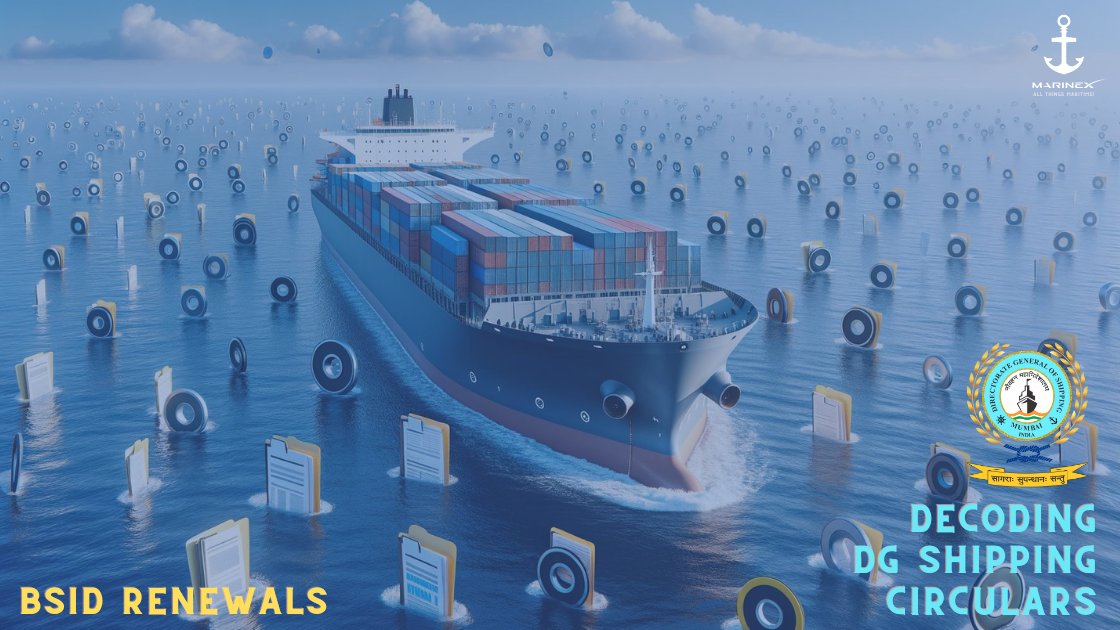Enhancing Seafarer Identification: DG Shipping India's Circular on BSID Implementation and Renewal


At MarineX, we have been receiving emails from our readers requesting assistance in understanding IMO and DG Shipping circulars. To address this need, we have appointed a dedicated team that will tirelessly work on decoding these circulars. Our goal is to help the maritime community stay updated with the latest information and regulations.
This blog decodes one of the latest DG Shipping circulars on BSID Renewal.
The Directorate General of Shipping (DG Shipping) in India has issued a new circular to streamline and enhance the identification process for seafarers.
Historical Context and Evolution
The journey towards a universal identification system for seafarers began with the International Labour Organisation (ILO) Convention C-108 on Seafarers' Identity Document 1958, which came into force on February 19, 1961.
These rules were later updated in 2001 to include the Continuous Discharge Certificate (CDC) cum Seafarer's Identity Document (SID).
Example:
A seafarer working on international voyages would carry a CDC cum SID, serving as their official identification and recording their sea service.
The Role of CDC Documents
Traditionally, CDC documents have been issued as booklets that serve multiple purposes: official identification, sea service records, and certification.
These documents ensure compliance with international standards and regulations regarding seafarer documentation.
Example:
When a seafarer joins or leaves a ship, their CDC booklet is updated with details of their sea service, including dates and ship particulars, providing proof of their experience.
Introduction of ILO Convention C185
In 2003, the ILO introduced Convention C185, revising the seafarers' identity documents system. This convention came into effect on February 9, 2005.
India ratified C185 on October 9, 2015, leading to the automatic denunciation of the earlier Convention C-108 on October 8, 2016.
Example:
With the ratification of C185, India transitioned to a new system with updated security features and standards for seafarers' identity documents.
Merchant Shipping (Seafarer's Biometric Identity Document) Rules, 2016

On April 11, 2016, the Merchant Shipping (Seafarer's Biometric Identity Document) Rules were notified, streamlining the issuance of Biometric Seafarer's Identity Documents (BSID) for Indian seafarers.
This system, launched on April 5, 2019, introduced chip-based cards, distinguishing BSIDs from CDCs.
Example:
A seafarer receiving a BSID after April 5, 2019, would get a separate chip-based card, enhancing their identification with biometric data.
Implementation of ILO Convention C185 Regulations
The regulations introduced under ILO Convention C185 mandated the issuance of separate chip-based BSIDs, enhancing the identification process within the maritime sector by differentiating BSIDs from CDCs.
Example:
A seafarer now carries a CDC for recording their sea service and a BSID for identification, with the BSID containing advanced biometric features.
Merchant Shipping (Continuous Discharge Certificate) Rules, 2017
In 2017, the term "Seafarer's Identity Document" was omitted from the Merchant Shipping (Continuous Discharge Certificate) Rules. Consequently, CDC booklets issued under these rules now display the inscription "Continuous Discharge Certificate only."
Example:
A seafarer issued a CDC after 2017 will see "Continuous Discharge Certificate only" on their booklet, indicating it no longer serves as an identity document.
Addressing Complaints and Providing Resolutions
The Directorate received complaints from seafarers issued with CDCs before 2017, which still bore the inscription "Continuous Discharge Certificate-cum-Seafarer's Identity Document," causing validation issues regarding SID compliance. After consultations with stakeholders, the following resolutions were made:
- CDCs with the inscription "Continuous Discharge Certificate-cum-Seafarer's Identity Document" will now be treated solely as CDC booklets for recording sea service and voyage details.
- Seafarers must ensure accurate entries in their CDCs and obtain the Master's signature correctly recording the date of signing off from the vessel, as detailed in column 2 of the CDC booklet.
- As per MS Notice 2 of 2019, BSIDs are valid for 10 years, with renewal required after the first 5 years. BSIDs issued in 2019 must be renewed in 2024. Seafarers should apply for renewal within six months prior to the expiry of their BSIDs.
- Seafarers must follow the renewal instructions detailed on the BSID online portal and visit the nearest Shipping Master Office (SMO) or BSID center for compliance.
- Regardless of the original issuance location, seafarers can choose any approved location for BSID renewal based on their convenience.
Choice of Renewal Location:
Example:
A seafarer who originally received their BSID in Mumbai can choose to renew it in Chennai or any other approved location.
Renewal Process:
Example:
A seafarer should visit the BSID Guidelines for detailed renewal procedures and approach the nearest authorized center for BSID renewal.
BSID Validity and Renewal:
Example:
A BSID issued on April 5, 2019, must be renewed by April 4, 2024. The seafarer should apply for renewal anytime after October 5, 2023.
Ensuring Correct Entries:
Example:
If a seafarer signs off from a vessel on June 1, 2024, this date must be correctly entered and signed by the Master in the CDC booklet.
To read complete blog subscribe to our premium plans